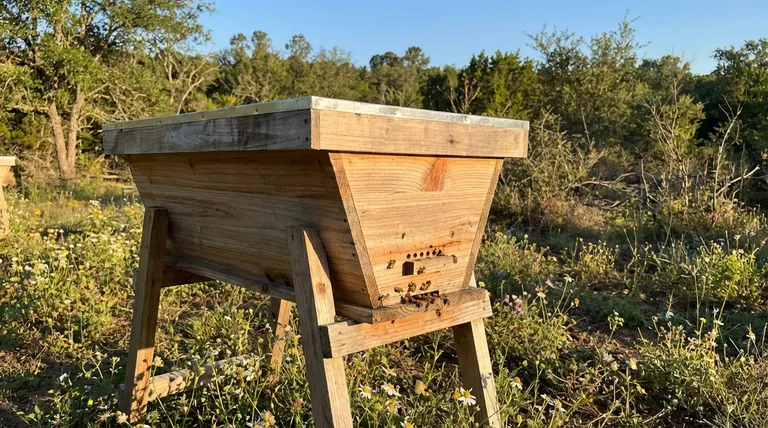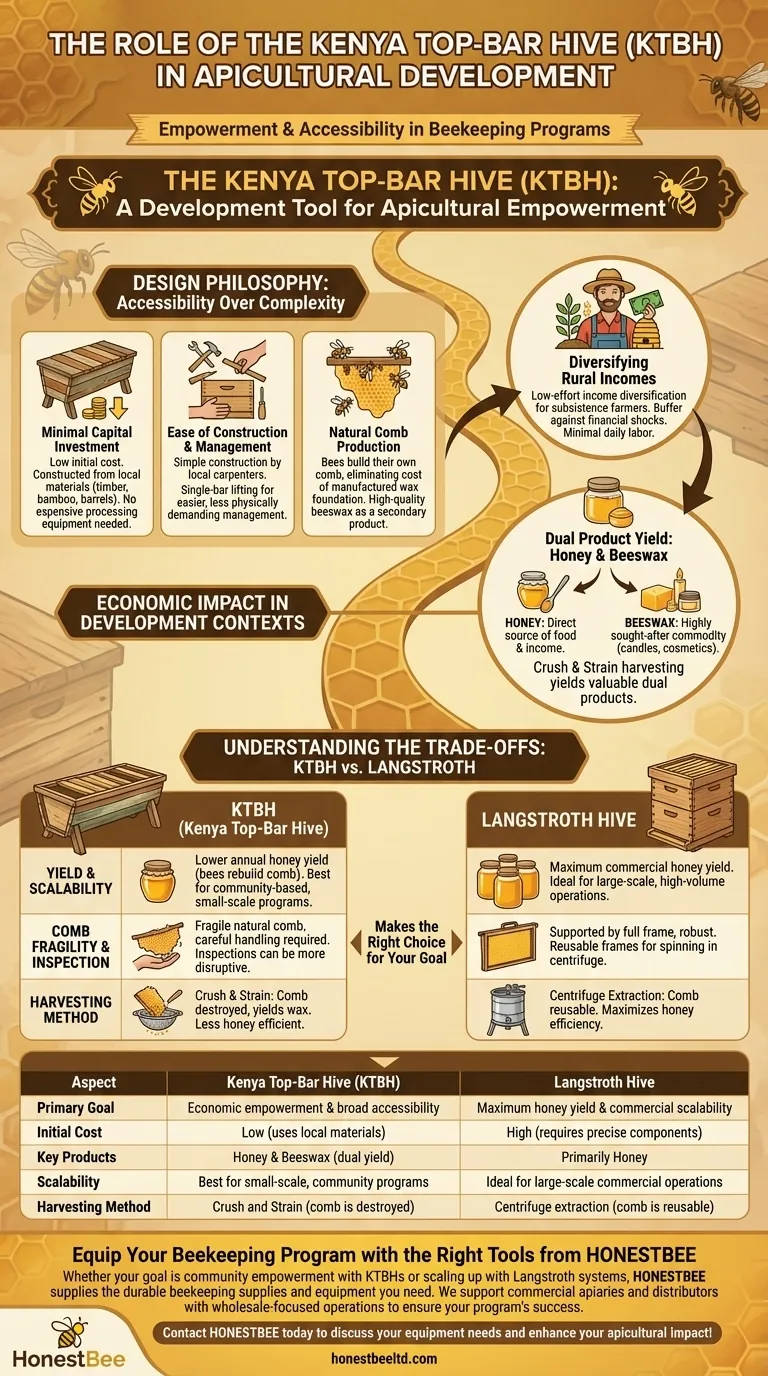The Kenya Top-Bar Hive (KTBH) serves as a critical entry point for apicultural development programs, designed specifically to make beekeeping accessible and economically viable. It provides a low-cost, low-technology solution that empowers small-scale beekeepers in rural or resource-limited areas to generate income from honey and beeswax without the significant capital investment required by more complex systems.
The true role of the KTBH is not to compete with industrial hives on production, but to act as a development tool. It prioritizes local accessibility, sustainability, and economic empowerment over the sheer maximization of honey yield.

The Design Philosophy: Accessibility Over Complexity
The effectiveness of the KTBH in development programs stems directly from its intentional design, which favors simplicity and the use of local resources. This approach systematically removes common barriers to entry for aspiring beekeepers.
Minimal Capital Investment
Unlike the Langstroth hive, which often requires precisely milled wooden components, the KTBH can be constructed from a wide range of locally available materials, such as off-cut timber, bamboo, or even repurposed barrels.
This dramatically reduces the initial financial barrier, making it a feasible venture for individuals and communities with limited capital. The hive is the primary expense; no centrifuge or expensive processing equipment is mandatory.
Ease of Construction and Management
The KTBH's simple, trough-like shape can be built by local carpenters with basic tools and skills. This not only makes the hives cheaper but also keeps the investment within the local economy.
Managing the hive involves lifting individual top bars rather than heavy boxes, making it physically less demanding and more accessible to a wider range of people.
Natural Comb Production
In a KTBH, bees build their own comb, drawing it down naturally from the single top bar. This eliminates the need for manufactured wax foundation sheets, further reducing costs and reliance on external supply chains.
This natural comb-building process is also a primary source of high-quality beeswax, a valuable secondary product.
Economic Impact in Development Contexts
The KTBH is more than just a piece of beekeeping equipment; it is an engine for localized economic activity.
Diversifying Rural Incomes
For subsistence farmers, beekeeping with KTBHs offers a low-effort way to diversify their income streams. Bees forage for themselves, requiring minimal daily labor from the beekeeper outside of periodic inspections and harvesting.
This new income can provide a crucial buffer against crop failure or other financial shocks.
Dual Product Yield: Honey and Beeswax
The KTBH is designed for the "crush and strain" method of harvesting. While this means the comb is destroyed, it yields two distinct and valuable products.
Honey provides a direct source of food and income. Beeswax is a highly sought-after commodity for making candles, cosmetics, and polishes, often fetching a high price and providing a significant portion of the beekeeper's revenue.
Understanding the Trade-offs: KTBH vs. Langstroth
To deploy the KTBH effectively, it is crucial to understand its limitations. It is a specific tool for a specific purpose, not a universal replacement for all other hive types.
Yield and Scalability
The Langstroth hive is the undisputed standard for large-scale, commercial honey production. Its interchangeable boxes and reusable frames (which can be spun in a centrifuge) are designed for maximum efficiency and honey yield.
The KTBH, by contrast, generally produces less honey per year because the bees must expend energy rebuilding comb after each harvest. It is not designed for industrial-scale operations.
Comb Fragility and Inspection
The natural combs in a KTBH are attached only to the top bar and are not supported by a full frame. They are fragile and must be handled with care to prevent breakage, especially in hot weather.
While hive inspections are straightforward, they can be more disruptive than in a Langstroth hive if the beekeeper is not careful, as breaking comb attachments can distress the colony.
The "Crush and Strain" Reality
Harvesting by crushing the comb is simple and yields wax, but it is also inefficient from a honey production standpoint. The bees must consume significant amounts of honey (or nectar) to produce the wax needed to rebuild that comb.
This trade-off—sacrificing some potential honey for valuable wax and simplicity—is at the very core of the KTBH model.
Making the Right Choice for Your Goal
The decision to use a KTBH should be driven by the primary objective of the apicultural program.
- If your primary focus is community empowerment and broad-based income diversification: The KTBH is the superior choice due to its low cost, local adaptability, and dual-product yield that maximizes value for smallholders.
- If your primary focus is maximizing honey production for established commercial markets: The Langstroth hive is the industry standard for its efficiency, scalability, and robust design tailored for high-volume operations.
Ultimately, selecting the right hive is about matching the technology to the human context and the economic goal you aim to achieve.
Summary Table:
| Aspect | Kenya Top-Bar Hive (KTBH) | Langstroth Hive |
|---|---|---|
| Primary Goal | Economic empowerment & broad accessibility | Maximum honey yield & commercial scalability |
| Initial Cost | Low (uses local materials) | High (requires precise components) |
| Key Products | Honey & Beeswax (dual yield) | Primarily Honey |
| Scalability | Best for small-scale, community-based programs | Ideal for large-scale commercial operations |
| Harvesting Method | Crush and Strain (comb is destroyed) | Centrifuge extraction (comb is reusable) |
Equip Your Beekeeping Program with the Right Tools from HONESTBEE
Whether your goal is community empowerment with KTBHs or scaling up with Langstroth systems, HONESTBEE supplies the durable beekeeping supplies and equipment you need. We support commercial apiaries and distributors with wholesale-focused operations to ensure your program's success.
Contact HONESTBEE today to discuss your equipment needs and enhance your apicultural impact!
Visual Guide

Related Products
- Top Bar Beehive for Beekeeping Wholesales Kenya Top Bar Hive
- HONESTBEE Professional Long Handled Hive Tool with Precision Cutting Blade
- HONESTBEE Advanced Ergonomic Stainless Steel Hive Tool for Beekeeping
- Professional Dual-End Stainless Steel Hive Tool for Beekeeping
- Long Langstroth Style Horizontal Top Bar Hive for Wholesale
People Also Ask
- Which is better Kenya top bar hive or Langstroth? Choose the Right Hive for Your Goals
- How is honey harvested from a top-bar hive? A Guide to Simple, Low-Equipment Processing
- What are the key features of the Kenyan Top Bar Hive? A Guide to Simpler, Natural Beekeeping
- What is the quickest method to harvest honey from a top bar hive? A Guide to the Simple 'Cut and Crush' Method
- Why are hive inspections easier with Top Bar Hives? Achieve a Calmer, Safer Approach to Beekeeping



















